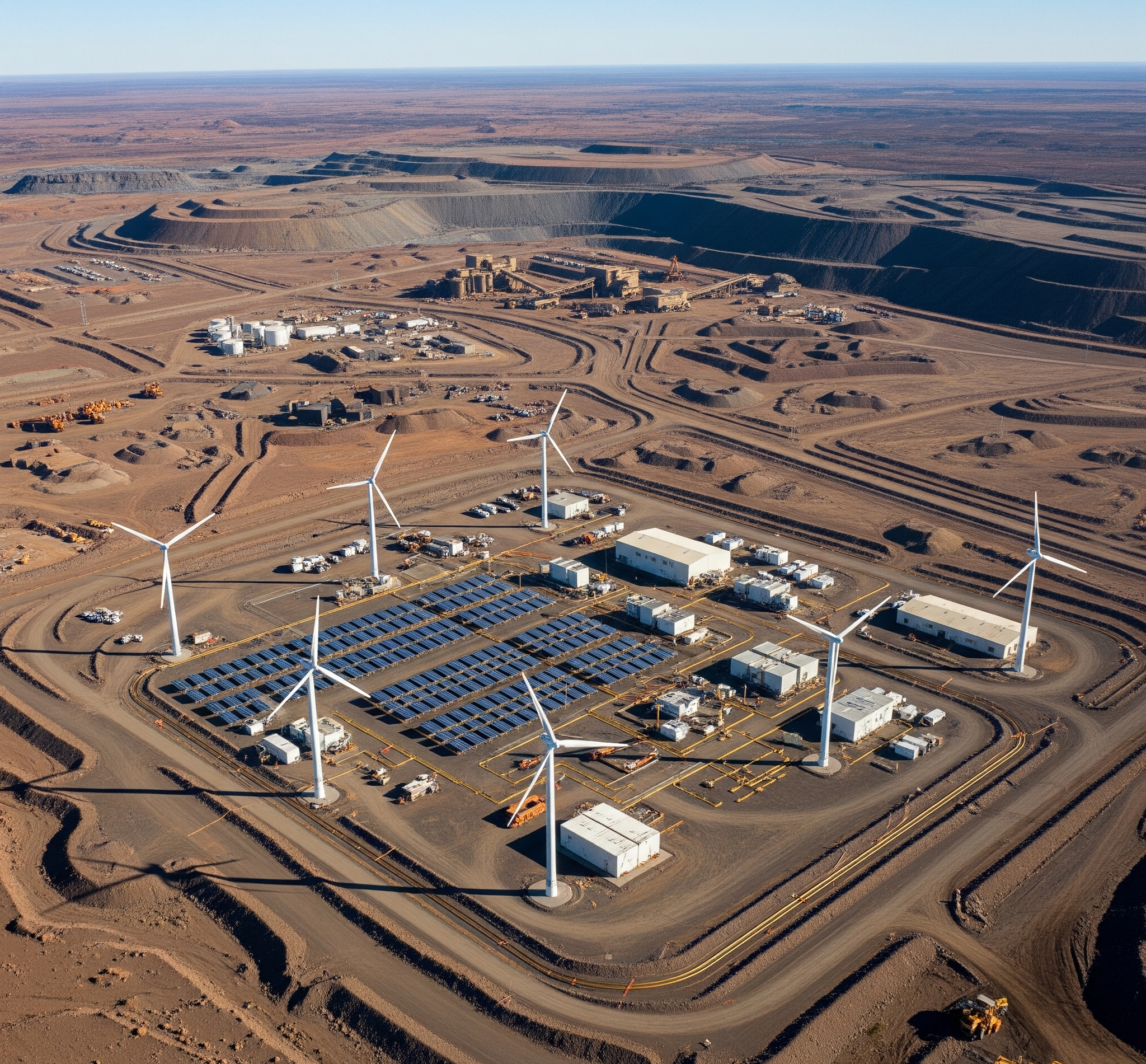What Exactly is a Microgrid?
What is a Microgrid? Explore microgrids: independent, local energy systems combining solar, batteries, and generators for reliable power. Learn how Barloworld Power provides complete microgrid solutions, ensuring energy independence and efficiency.
Imagine a traditional power grid as a vast, centralised network, like a single, massive power plant sending electricity to homes and businesses over long distances. If that central plant goes down, large areas are affected.
A microgrid, on the other hand, is a more localised and independent energy system. Think of it as a miniature version of the main grid, able to produce power from various sources within a defined area. The magic lies in its ability to bring together different power-producing components, such as diesel/gas generators, solar panels, and battery storage, and then intelligently control them to optimise operation.
The most critical aspect of a microgrid is its capacity for "captive power." This means it can operate independently of the national grid, providing a reliable and consistent power supply even if the main grid experiences outages. For example, a mine in a remote location can run entirely on its own microgrid. However, microgrids are also designed to work in conjunction with the national grid, acting as a backup in case of power interruptions or seamlessly integrating when grid power is available.
The term "microgrid" comes to life when you consider its diverse technological composition. It’s a synergy of different power sources – an engine that can run on gas or diesel, complemented by solar panels and battery storage. The "brain" of this entire operation is the microgrid controller. This sophisticated system intelligently manages power flow, switching generators on and off, controlling battery usage, and ultimately determining what power comes in and what goes out, making it a uniquely versatile solution.
Why Are Microgrids So Relevant Right Now? Addressing Key Energy Challenges
The global energy landscape is facing unprecedented challenges, from the need for greater energy independence to the increasing demand for sustainable and reliable power. This is precisely where microgrids become indispensable.
One of their primary advantages is their modularity. Microgrids can be designed to be small, catering to the needs of a single facility with a 1 MW unit, but they are also scalable, capable of expanding to support operations requiring up to 60 MW. This flexibility makes them suitable for a wide range of users and applications, adapting to diverse power demands.
Where Microgrids Make the Biggest Impact: A Focus on Key Sectors
- Consider a greenfield mining operation in an uncharted, often remote, territory. Establishing a mine in the middle of nowhere requires substantial power to set up camp and commence operations. Unlike traditional grid systems that necessitate extensive infrastructure development, a microgrid system has minimal infrastructure requirements, allowing projects to get off the ground quickly and efficiently, regardless of their location.
The Anatomy of a Mine Microgrid: A Complete Integrated Suite
- In addition to the generator sets, the microgrid would feature containerised battery storage. These batteries are primarily charged by solar panels. The size and number of solar panels would depend on the available land on the mine site, feeding power directly into the battery system.
- In this setup, the generator sets are not the primary function. Instead, the operation would run predominantly off the battery power drawn from the solar panels. The generator sets would only kick in as a "spinning reserve" once the battery is depleted, typically in the middle of the night or during periods of low solar irradiation.
- It's important to understand the inherent limitations of renewable energy sources like solar. While they efficiently charge batteries during the day, continuous power requires a backup once the sun sets and batteries are depleted. This is where the generator set proves invaluable, ensuring 24/7 power availability. For mining sites that operate under a base load and require uninterrupted power, the spinning reserve provided by the generators is critical for maintaining consistent operations.
- In this setup, the generator sets are not the primary function. Instead, the operation would run predominantly off the battery power drawn from the solar panels. The generator sets would only kick in as a "spinning reserve" once the battery is depleted, typically in the middle of the night or during periods of low solar irradiation.
The Power of Integration: Why a Holistic Microgrid Solution is Paramount
- The initial capital expenditure (CapEx) for a microgrid can be significant. However, the most substantial savings are realised in the operational expenditure (OpEx), specifically on fuel and maintenance costs. If you rely solely on generator sets, your fuel, oil, and maintenance bills will be considerably higher. By integrating the system with batteries and solar, you can periodically switch off the generator sets, drastically reducing fuel consumption and maintenance requirements.
- Integrating these diverse components into a single, cohesive system allows for optimal power usage and balancing. You can intelligently decide on the most efficient and cost-effective power source at any given time, depending on the use case and time of day, thereby maximising the benefits of each system. We leverage the concept of a levelised cost of producing power, allowing us to run on the most efficient and cheapest form of power available from our various sources.
Barloworld Power’s Holistic Approach: From Concept to Continuous Support
- The process begins with in-depth consultation. We sit down with our customers to understand their specific needs and design the most optimal microgrid solution for their operations. Once the final design is chosen, Barloworld Power takes charge of the entire Engineering, Procurement, and Construction (EPC) process. This means we supply the necessary equipment and handle the complete building of the site, ensuring a seamless implementation of the plant.
- Our support doesn't end there. Once the microgrid is up and running, we provide comprehensive maintenance and after-sales support, including remote monitoring, to ensure the plant runs adequately and efficiently for its entire lifespan.
Our Innovative Battery Solutions: A Key Differentiator
- This strategic shift is driven by advancements in technology. We have found that our inverters and, critically, our microgrid controller – the "brain" of the CAT product – are where we truly excel. We dedicate significant time, effort, and energy to the development of our microgrid controller, which is our key differentiator. This sophisticated controller manages all components within the system – from batteries and solar panels to generators – intelligently switching them on and off to ensure the most optimal power usage at any given time.
What Sets Barloworld Power Apart in the African Market?
- Firstly, our extensive footprint across over 10 countries in Africa is a significant advantage. This allows us to not only supply equipment but also provide robust aftermarket and support services directly in-country.
- Secondly, our in-country technical expertise is unparalleled. We have highly skilled professionals for all respective components and parts, ensuring prompt and effective support. This contrasts sharply with some newer market entrants who may offer seemingly cheaper products but lack the vital after-sales support that is crucial for long-term operational success.
The Future of Microgrids: Staying at the Forefront of Evolution
- This collaboration ensures continuous upgrades to our microgrid controllers, batteries, and inverters. We are also constantly abreast of advancements in generator sets, particularly concerning emissions and fuel consumption, as these areas represent our greatest value add. Our development efforts are not localised but incorporate the latest and greatest global technology into our systems, ensuring that our customers in Africa benefit from cutting-edge solutions.
- At Barloworld Power, we are committed to building lasting partnerships and providing comprehensive, innovative, and reliable power solutions that redefine the future of energy in Africa.
 Articulated trucks
Articulated trucks
-1.webp) Dozers
Dozers
-1-1.png) Backhoe Loaders
Backhoe Loaders
 Hydraulic Mining Shovels
Hydraulic Mining Shovels
 ELECTRIC POWER
ELECTRIC POWER
 MARINE POWER
MARINE POWER
 INDUSTRIAL
INDUSTRIAL
 OIL AND GAS
OIL AND GAS
.png) RENTALS
RENTALS














